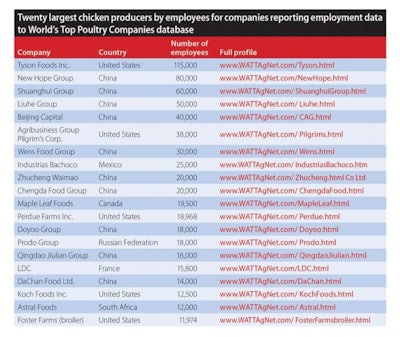
According to data submitted to the World's Top Poultry Companies database, of the 20 largest chicken producers in the world, 10 are based in China, five are located in the U.S., while Canada, France, Mexico, the Russian Federation and South Africa can lay claim to one each.
Between them, these 20 companies report employing almost 635,000 staff.
The Top Companies employment ranking is based on employment figures submitted by companies contributing to the World's Top Companies database. Consequently, if a company does not submit employment data, it cannot be included in the ranking.
As far as possible, we have attempted to include only that data which relates to poultry production, but some companies do not break down their employment figures by activity. For inclusion, any company must include chicken production, rather than other poultry meats or eggs, as an activity.
When looking at the figures, it should also be kept in mind that some local operations report independently to their parent operations, while some groups report as a whole. Nevertheless, the ranking provides an interesting glimpse into just how many people are involved in chicken production around the world and how, in certain regions, working in the poultry industry is a relatively new activity for a surprisingly high number of people.
According to data submitted, the U.S.'s Tyson Foods would appear to be biggest employer amongst the world's chicken producers. The company produces 1,872 million birds each year and reports having a staff of 115,000. It far outstrips the country's second largest employer in the sector, Pilgrim's Corporation, which reports having a staff of 38,000 and comes in at 6th place in the overall ranking.
Positions 2 to 5 are held by Chinese companies, with New Hope Group ranking as the second largest employer listed, with 80,000 staff. Chengdu-based New Hope Group is one of China's largest agribusiness enterprises, and a little over a year ago announced plans to move into African and European markets via acquisition. While its annual processing capacity is listed as 750 million head, the company has announced that it is aiming for annual production of in excess of 2 billion chickens and 2 million ducks. The hiring of more staff is almost certain to be expected, and the total number worldwide likely to rise through company acquisitions.
Positions 20 through 30 offer a more mixed picture, with the U.K. taking positions 22 and 23, and Egypt, Ukraine and Japan making an appearance.
Change ahead
To enter the top 20 largest employers, any company must have more than 11,500 employees. There are a few contenders that could see themselves reach the lower rankings over the next couple of years, as 25 companies report having 10,000 employees or more.
The five companies that are hovering just outside the top 20 are mostly operating in markets where either total demand is growing or there is a growing preference for locally produced food, which is likely to result in increased production and a need for further hiring.
Conversely, there is more than one company in the lower ranks of the top 20 which operates in a market that is increasingly subject to pressure from imports, and so could well cut production, and consequently staffing levels, over coming years, so seeing its ranking decrease.
Perhaps surprising is how many companies based in the developed world feature among the largest employers, particularly as labor costs tend to be higher and the deployment of technology - rather than human capital - greater. Again, over time, this is something that can only be expected to change, particularly as more investment is made in developing countries, demand for chicken meat in those countries rises, and trade increases via free trade and similar agreements.

















